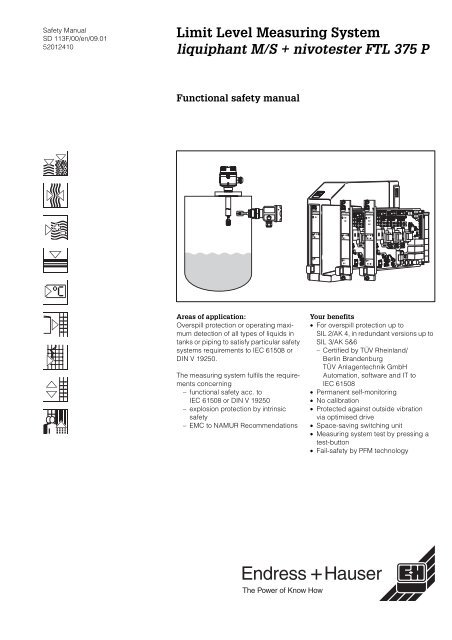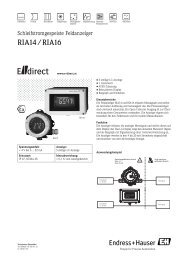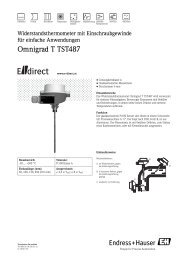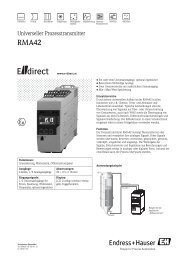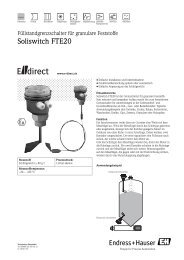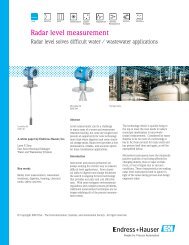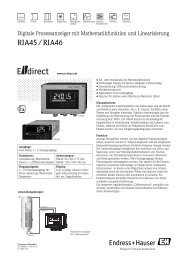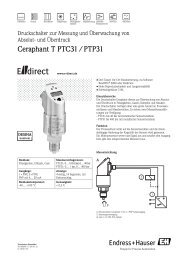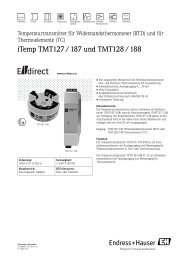Limit Level Measuring System liquiphant M/S + nivotester FTL 375 P
Limit Level Measuring System liquiphant M/S + nivotester FTL 375 P
Limit Level Measuring System liquiphant M/S + nivotester FTL 375 P
You also want an ePaper? Increase the reach of your titles
YUMPU automatically turns print PDFs into web optimized ePapers that Google loves.
Safety Manual<br />
SD 113F/00/en/09.01<br />
52012410<br />
<strong>Limit</strong> <strong>Level</strong> <strong>Measuring</strong> <strong>System</strong><br />
<strong>liquiphant</strong> M/S + <strong>nivotester</strong> <strong>FTL</strong> <strong>375</strong> P<br />
Functional safety manual<br />
Areas of application:<br />
Overspill protection or operating maximum<br />
detection of all types of liquids in<br />
tanks or piping to satisfy particular safety<br />
systems requirements to IEC 61508 or<br />
DIN V 19250.<br />
The measuring system fulfils the requirements<br />
concerning<br />
– functional safety acc. to<br />
IEC 61508 or DIN V 19250<br />
– explosion protection by intrinsic<br />
safety<br />
– EMC to NAMUR Recommendations<br />
Your benefits<br />
• For overspill protection up to<br />
SIL 2/AK 4, in redundant versions up to<br />
SIL 3/AK 5&6<br />
– Certified by TÜV Rheinland/<br />
Berlin Brandenburg<br />
TÜV Anlagentechnik GmbH<br />
Automation, software and IT to<br />
IEC 61508<br />
• Permanent self-monitoring<br />
• No calibration<br />
• Protected against outside vibration<br />
via optimised drive<br />
• Space-saving switching unit<br />
• <strong>Measuring</strong> system test by pressing a<br />
test-button<br />
• Fail-safety by PFM technology
Safety Manual Nivotester <strong>FTL</strong> <strong>375</strong> P + Liquiphant M/S<br />
Contents<br />
Introduction<br />
Terms and standards<br />
General depiction of a safety system (protection function)<br />
Version tables for determining Safety Integrity <strong>Level</strong> (SIL)<br />
Sensors in the safety system with Liquiphant M/S (FEL 57) and<br />
Nivotester <strong>FTL</strong> <strong>375</strong> P<br />
<strong>Measuring</strong> system<br />
Safety function<br />
Permitted combination of Nivotester with Liquiphant M/S for the safety function<br />
Safety function data<br />
Supplementary device documentation<br />
Settings and installation instructions<br />
Response in operation and failure<br />
Recurrent functional tests of the measuring system<br />
Appendix<br />
Specific values and wiring options for the measuring system<br />
Liquiphant M/S (FEL 57) and Nivotester <strong>FTL</strong> <strong>375</strong> P<br />
2 Endress+Hauser
Nivotester <strong>FTL</strong> <strong>375</strong> P + Liquiphant M/S Safety Manual<br />
Introduction<br />
Terms and standards Abbreviations<br />
PFD Probability of dangerous Failure on<br />
Demand<br />
PFD av<br />
Tab. 1: Definitions from IEC 61508 Part 4<br />
Relevant standards<br />
Tab. 2: Relevant standards<br />
Probability (average) of a dangerous<br />
Failure on Demand<br />
SIL Safety Integrity <strong>Level</strong><br />
Discrete level (one out of possible four)<br />
for specifying the safety integrity<br />
requirements of the safety functions to be<br />
allocated to the E/E/PE safety related<br />
systems where safety integrity level 4 has<br />
the highest level of safety integrity and<br />
safety integrity level 1 has the lowest<br />
HFT Hardware Fault Tolerance<br />
Ability of a functional unit (hardware) to<br />
continue to perform a required function in<br />
the presence of faults or errors<br />
SFF Safe Failure Fraction<br />
Fraction of failure which do not have the<br />
potential to put the safety-related system<br />
in a hazardous or fail-to-function state<br />
CCF , CC Common Cause Failure<br />
Failure which is the result of one or more<br />
events causing coincident failures of two<br />
or more separate channels in a multiple<br />
channel system, leading to system failure<br />
E/E/PE Electrical / Electronic / Programmable<br />
Electronic <strong>System</strong><br />
XooY "x out of y“ voting (e.g. 2oo3)<br />
MTTR Mean Time To Repair<br />
MTBF Mean Time Between Failure<br />
TI Test Interval between life testing of the<br />
protection function (in years)<br />
IEC 61508<br />
Part 1-7<br />
IEC 61511<br />
Part 1-3<br />
Draft<br />
DIN V VDE<br />
0801 A1<br />
DIN V<br />
19250<br />
Functional safety of programmable<br />
electronic safety-related systems<br />
(Target group: Manufacturers & Suppliers<br />
of Devices)<br />
Functional safety instrumented systems<br />
for the process industry sector.<br />
(Target group: Safety Instrumented<br />
<strong>System</strong>s Designers, Integrators & Users)<br />
Principles for computers in safety-related<br />
systems (including Amendment A1)<br />
Fundamental safety aspects for<br />
measurement and control equipment<br />
Endress+Hauser 3
Safety Manual Nivotester <strong>FTL</strong> <strong>375</strong> P + Liquiphant M/S<br />
General display of a safety<br />
system (protection<br />
function)<br />
Terms<br />
Safety system<br />
Safety function<br />
Tab. 3: Terms<br />
Version tables for determining Safety Integrity <strong>Level</strong> (SIL)<br />
The following tables are used to define the reachable SIL or the requirements pertaining<br />
to the "Average Probability of a Dangerous Failure On Demand" (PFD av ), "Hardware Fault<br />
Tolerance" (HFT) and the "Safe Failure Fraction" (SFF) of the safety system. Refer to the tables in<br />
the Appendix for the specific values of the measuring systems Liquiphant M/S (FEL 57) and<br />
Nivotester <strong>FTL</strong> <strong>375</strong> P.<br />
The relationship between AK-classes according to DIN V 19250 and the Safety<br />
Integrity <strong>Level</strong> (SIL) according to IEC 61508:<br />
AK-classes<br />
(DIN V 19250)<br />
Tab. 4: Relationship between AK and SIL<br />
Permitted failure probability of the complete safety system as a function of SIL for systems which<br />
must react on demand (e.g. sensor signal when covered).<br />
Tab. 5: Permitted failure probabilities (Source: IEC 61508, Part 1)<br />
The ranges of PFD av are generally distributed as follows for the whole safety system:<br />
Fig. 1: General distribution of PFD av<br />
Complete safety-related measuring<br />
chain (protection function)<br />
Defined function performed by the<br />
system on demand<br />
Safety Integrity <strong>Level</strong> SIL<br />
(IEC 61508)<br />
1 –<br />
2 & 3 � 1<br />
4 � 2<br />
5 & 6 � 3<br />
7 & 8 � 4<br />
SIL PFDav 4 ≥10-5 ...< 10-4 3 ≥10 -4 ...< 10 -3<br />
2 ≥10 -3 ...< 10 -2<br />
1 ≥10 -2 ...< 10 -1<br />
4 Endress+Hauser
Nivotester <strong>FTL</strong> <strong>375</strong> P + Liquiphant M/S Safety Manual<br />
Sensors in the<br />
measuring system with<br />
Liquiphant M/S (FEL 57)<br />
and Nivotester <strong>FTL</strong> <strong>375</strong> P<br />
The following table shows the achievable Safety Integrity <strong>Level</strong> (SIL) as a function of the amount<br />
of safety-oriented errors and the hardware fault tolerance of the complete safety system for type<br />
B systems (complex components, for definition see IEC 61508, Part 2):<br />
SFF HFT<br />
0 1 2<br />
none: < 60% not allowed SIL 1 SIL 2<br />
low: 60 % ...< 90 % SIL 1 SIL 2 SIL 3<br />
medium: 90 % ...
Safety Manual Nivotester <strong>FTL</strong> <strong>375</strong> P + Liquiphant M/S<br />
Safety function<br />
The safety function applies to all settings in MAX safety (monitoring of the covered state) and use<br />
of the NO contacts of the level relays or use of transistor outputs in conjunction with an evaluation<br />
unit (e.g. PLC).<br />
The following settings are permitted for the safety function:<br />
Instrument Setting As-delivered state<br />
Liquiphant Density switch setting: 0.5<br />
Density switch setting: 0.7<br />
Nivotester<br />
<strong>FTL</strong><strong>375</strong>P-###1<br />
(One-channel<br />
instrument)<br />
Nivotester<br />
<strong>FTL</strong><strong>375</strong>P-###2<br />
(Two-channel<br />
instrument)<br />
Nivotester<br />
<strong>FTL</strong><strong>375</strong>P-###3<br />
(Three-channel<br />
instrument)<br />
Tab. 7: Settings<br />
Test mode "STD"<br />
Test mode "EXT"<br />
Density switch setting: 0.7<br />
Test mode "STD"<br />
MAX Safety MAX Safety<br />
One-channel operation<br />
MAX Safety MAX Safety<br />
All settings except<br />
"∆S function" (see Chap. "Settings and<br />
installation instructions")<br />
Two-channel operation<br />
MAX Safety MAX Safety<br />
All settings except<br />
"∆S function" (see Chap. "Settings and<br />
installation instructions")<br />
Three-channel operation<br />
The MAX safety setting has the effect that the level relay or the transistor output always work in<br />
quiescent current safety, i.e. the relay releases or the transistor output is disabled when:<br />
• the switch point is exceeded (level exceeds response height)<br />
• a fault occurs<br />
• mains voltage fails<br />
In addition to the level relay, the alarm relay or the alarm transistor output works in quiescent<br />
current safety and releases or is disabled when<br />
• one of the following faults occur:<br />
– the sensor line is interrupted<br />
– the sensor line short circuits<br />
– the sensor identifies corrosion at the vibration system<br />
• mains voltage fails<br />
Note!<br />
• When the alarm relay releases or when the alarm transistor output is disabled, the level relays<br />
also release or the transistor outputs also are disabled.<br />
6 Endress+Hauser
Nivotester <strong>FTL</strong> <strong>375</strong> P + Liquiphant M/S Safety Manual<br />
Permitted combination of Nivotester with Liquiphant M/S for the safety function<br />
The following instrument combinations are permitted for the measuring system:<br />
One-channel<br />
instrument:<br />
<strong>FTL</strong> <strong>375</strong> P-H##1<br />
<strong>FTL</strong> <strong>375</strong> P-P##1<br />
<strong>FTL</strong> <strong>375</strong> P-T##1<br />
Tab. 8: Permitted instrument types (# = all instrument versions permitted); * 7 = FEL 57<br />
Safety function data<br />
Nivotester Liquiphant M +<br />
Two-channel Three-channel<br />
FEL 57<br />
instrument: instrument:<br />
<strong>FTL</strong> <strong>375</strong> P-H##2<br />
<strong>FTL</strong> <strong>375</strong> P-P##2<br />
<strong>FTL</strong> <strong>375</strong> P-T##2<br />
The mandatory settings and data for the safety function can be found in the APPENDIX.<br />
The response time of the measuring system is ≤ 0.9 s.<br />
Note!<br />
MTTR is set at eight hours.<br />
Safety systems without a self-locking function must be monitored or set to an otherwise safe state<br />
after carrying out the safety function within MTTR.<br />
Supplementary device documentation<br />
The following must be available for the measuring system:<br />
Tab. 9: Supplementary documentation<br />
<strong>FTL</strong> <strong>375</strong> P-H##3<br />
<strong>FTL</strong> <strong>375</strong> P-P##3<br />
<strong>FTL</strong> <strong>375</strong> P-T##3<br />
Nivotester <strong>FTL</strong> <strong>375</strong> P For all instrument types:<br />
TI TI 360F<br />
360F<br />
Liquiphant M Types:<br />
<strong>FTL</strong> 50, <strong>FTL</strong> 51,<br />
<strong>FTL</strong> 50 H, <strong>FTL</strong> 51 H:<br />
TI TI 328F<br />
328F<br />
<strong>FTL</strong> 50-######7###*<br />
<strong>FTL</strong> 51-######7###*<br />
<strong>FTL</strong> 50 H-######7###*<br />
<strong>FTL</strong> 51 H-######7###*<br />
<strong>FTL</strong> 51 C-######7####*<br />
Technical Information Operating Instructions<br />
Type:<br />
<strong>FTL</strong> 51 C<br />
TI TI 354F<br />
354F<br />
Liquiphant S For all instrument types:<br />
TI TI 354F<br />
354F<br />
Relevant contend Connection data<br />
Installation instructions<br />
Liquiphant S +<br />
FEL 57<br />
<strong>FTL</strong> 70-######7####*<br />
<strong>FTL</strong> 71-######7####*<br />
One-channel instrument <strong>FTL</strong> <strong>375</strong> P-###1: KA KA 174F<br />
174F<br />
Two-channel instrument <strong>FTL</strong> <strong>375</strong> P-###2: KA KA 175F<br />
175F<br />
Three-channel instrument <strong>FTL</strong> <strong>375</strong> P-###3: KA KA 176F<br />
176F<br />
Types: <strong>FTL</strong> 50, <strong>FTL</strong> 51: KA KA 143F 143F<br />
143F<br />
Types: <strong>FTL</strong> 50, <strong>FTL</strong> 51: KA KA 163F 163F<br />
163F<br />
(with aluminium housing/separate terminal<br />
compartment)<br />
Types: <strong>FTL</strong> 50 H, <strong>FTL</strong> 51 H: KA KA 144F<br />
144F<br />
Types: <strong>FTL</strong> 50 H, <strong>FTL</strong> 51 H: KA KA 164F<br />
164F<br />
(with aluminium housing/separate terminal<br />
compartment)<br />
Type: <strong>FTL</strong> 51 C: KA KA 162F<br />
162F<br />
Type: <strong>FTL</strong> 51 C: KA KA 165F<br />
165F<br />
(with aluminium housing/separate terminal<br />
compartment)<br />
Types <strong>FTL</strong> 70, <strong>FTL</strong> 71: KA KA 172F<br />
172F<br />
Types: <strong>FTL</strong> 70, <strong>FTL</strong> 71: KA KA 173F<br />
173F<br />
(with aluminium housing/separate terminal<br />
compartment)<br />
Setting, configuration, remarks, function tests<br />
Endress+Hauser 7
Safety Manual Nivotester <strong>FTL</strong> <strong>375</strong> P + Liquiphant M/S<br />
Settings and installation instructions<br />
Installation<br />
The Nivotester <strong>FTL</strong> <strong>375</strong> P is installed in the Endress+Hauser Racksyst II assembly rack (FXG 1)<br />
or in the Monorack II. The ambient conditions for the assembly rack or the Monorack must<br />
correspond to IP54 (as per EN 60529). Please pay special attention to the instructions and<br />
requirements stated in TI 183F (Monorack II) or TI 224 F (assembly rack).<br />
All components which are used in conjunction with the <strong>FTL</strong> <strong>375</strong> P in the assembly rack must<br />
observe EMC standards 89/336/EEC or equivalent national regulations. The measuring system<br />
must undergo a functional test after installation.<br />
Caution!<br />
Please note the following for the Nivotester <strong>FTL</strong> <strong>375</strong> P-####:<br />
The operator must use suitable measures (e.g. current limiter, fuses) to ensure the relay contact<br />
characteristics of<br />
• U ≤ 253 V AC 50/60 Hz , I ≤ 2.5 A, P ≤ 300 VA at cos ϕ ≥ 0.7 or<br />
• U ≤100 V DC, I ≤ 2.5 A, P ≤ 100 W<br />
are not exceeded and the permitted transistor output connection characteristics of<br />
• U ext ≤ 20...30 V DC<br />
• I max = 500 mA<br />
are observed.<br />
Caution!<br />
Changes to the measuring system and its settings after start-up can impair the protection<br />
function!<br />
Refer to the following documentation for instructions on setting the instruments:<br />
Instrument Setting description in documentation:<br />
Liquiphant M + FEL 57 KA 143F, KA 163F, KA 144F, KA 164F*, KA 165F, KA 162F*<br />
Liquiphant S + FEL 57 KA 172F, KA 173F<br />
Nivotester <strong>FTL</strong> <strong>375</strong> P-###1<br />
(one-channel)<br />
KA 174 F<br />
Nivotester <strong>FTL</strong> <strong>375</strong> P-###2<br />
(two-channel)<br />
KA 175 F<br />
Nivotester <strong>FTL</strong> <strong>375</strong> P-###3<br />
(three-channel)<br />
KA 176 F<br />
Tab. 10: Instrument documentation (* type-dependent, see Tab. 9)<br />
Settings for Liquiphant M/S (FEL 57):<br />
• The density switch setting has an influence on probability of failure and function test type<br />
(refer to the APPENDIX for details).<br />
• The test mode setting has influence on the function test (refer to the Tab. 13 for details).<br />
Settings for Nivotester <strong>FTL</strong> <strong>375</strong> P-###3 (3-channel version) and <strong>FTL</strong> <strong>375</strong> P-###2 (2-channel version)<br />
Instrument Setting Description � Caution!<br />
<strong>FTL</strong> <strong>375</strong> P-###2<br />
<strong>FTL</strong> <strong>375</strong> P-###3<br />
CH1<br />
CH2<br />
Tab. 11: Settings of the Nivotester<br />
Channels 1+2 in<br />
Delta-S function<br />
<strong>FTL</strong> <strong>375</strong> P-###3 Channel 3<br />
independent<br />
CH3<br />
CH1<br />
CH2<br />
∆S<br />
∆S<br />
Channels 1+2 in<br />
Delta-S function<br />
THIS SETTING IS NOT PERMITTED FOR<br />
THE SAFETY FUNCTION<br />
Channel 3 is permitted for the safety<br />
function<br />
CHANNELS 1 AND 2 IN THIS SETTING<br />
ARE NOT PERMITTED FOR THE SAFETY<br />
FUNCTION<br />
8 Endress+Hauser
Nivotester <strong>FTL</strong> <strong>375</strong> P + Liquiphant M/S Safety Manual<br />
Response in operation and failure<br />
Response in operation and failure is described in the following documentation:<br />
Instrument Description in documentation:<br />
Liquiphant M + FEL 57 KA 143F, KA 163F, KA 144F, KA 164F*, KA 165F, KA 162F*<br />
Liquiphant S + FEL 57 KA 172F, KA 173F<br />
Nivotester <strong>FTL</strong> <strong>375</strong> P-###1<br />
(one-channel)<br />
Nivotester <strong>FTL</strong> <strong>375</strong> P-###2<br />
(two-channel)<br />
Nivotester <strong>FTL</strong> <strong>375</strong> P-###3<br />
(three-channel)<br />
Tab. 12: Instrument documentation (* type-dependent, see Tab. 9)<br />
Recurrent function test of the measuring system<br />
The measuring system should be checked as follows:<br />
Setting<br />
Density switch<br />
KA 174 F<br />
KA 175 F<br />
KA 176 F<br />
Liquiphant M/S Nivotester Test<br />
Test mode<br />
setting<br />
Setting 0.7 STD or EXT Any permitted<br />
setting<br />
Setting 0.5 STD or EXT Any permitted<br />
setting<br />
Setting Test interval<br />
Annual function test**<br />
Annual function test**<br />
and<br />
complete test*:<br />
Covered signal monitoring,<br />
e.g. by approaching the<br />
level, at least every 5 years<br />
Tab. 13: Recurrent functional tests (* depending on type, see Tab. 9)<br />
Description of<br />
test procedure<br />
KA 174F *<br />
KA 175F *<br />
KA 176F *<br />
**Note the following points for the function test:<br />
• Test each channel individually by pressing the associated test key.<br />
• The electrical switching of the relay contacts and the transistor outputs must be checked:<br />
– Relay contacts: Electrical check, e.g. using a hand multimeter connected to the terminals.<br />
– Transistor outputs: Electrical check at the outputs or check with connected evaluation unit<br />
(e.g. PLC).<br />
– In multi-channel instruments, all channels which do not carry out a safety function must be<br />
included in the recurrent function tests if faulty functioning cannot be detected by any other<br />
means - e.g. by means of independent protective measures or changing the response of the<br />
measuring point.<br />
• A positive test result is obtained when the system reaction corresponds to the description.<br />
• If the system reaction does not correspond to the described procedure, the monitored<br />
process must be kept in a safe state by additional or different measures until the safety<br />
system is repaired.<br />
Endress+Hauser 9
Safety Manual Nivotester <strong>FTL</strong> <strong>375</strong> P + Liquiphant M/S<br />
Specific values and<br />
wiring options for<br />
the measuring system<br />
Liquiphant M/S (FEL 57)<br />
and Nivotester <strong>FTL</strong> <strong>375</strong> P<br />
APPENDIX<br />
The tables show the specific values and wiring options for the measuring system.<br />
Note!<br />
Note the following points on the tables below:<br />
• The PFD av values for multichannel systems already contain common cause errors for the<br />
associated wiring scheme. The PFD av values of the evaluation units are not contained in these<br />
values.<br />
• The PFD av values are only valid for associated wiring scheme. They are not suitable for deriving<br />
calculations for other wiring schemes.<br />
Using NC contacts instead of NO contacts requires further consideration of the installation<br />
means.<br />
• The wiring scheme shows the number of instruments (Liquiphant and Nivotester) and the<br />
switching of the limit level relay contacts (open, if sensor reports covered) or the switching of<br />
the transistor outputs (disabled, if sensor reports covered).<br />
• If there are several instruments in a wiring scheme they all have the same settings shown.<br />
• The evaluation units used must not effect the system and the design must comply with<br />
IEC 61508.<br />
• The transistor outputs are not suitable for series switching using external wiring.<br />
10 Endress+Hauser
Nivotester <strong>FTL</strong> <strong>375</strong> P + Liquiphant M/S Safety Manual<br />
X out of Y: 1oo1<br />
Liquiphant M/S setting Density 0.7 Density 0.5<br />
Nivotester <strong>FTL</strong> <strong>375</strong> P-###1<br />
Setting<br />
one-channel instrument<br />
One-channel<br />
operation<br />
SIL / AK SIL 2 / AK 4 SIL 2 / AK 4<br />
HFT 0 0<br />
SFF > 90 % > 90 %<br />
PFDav < 0.15 x10 -2 < 0.20 x 10 -2<br />
Wiring scheme Relay output:<br />
Transistor output:<br />
CH1/CH2:<br />
CH1/CH2:<br />
Function test with test key annual annual<br />
Complete function test, e.g. by<br />
approaching level<br />
One-channel<br />
operation<br />
not required within normal life at least every 5 years<br />
X out of Y: 1oo1<br />
Liquiphant M/S setting Density 0.7 Density 0.5<br />
Nivotester <strong>FTL</strong> <strong>375</strong> P-###3-<br />
Setting<br />
three-channel instrument<br />
CH3 in<br />
one-channel<br />
operation<br />
CH1/CH2 in<br />
∆ S function<br />
SIL / AK SIL 2 / AK 4 SIL 2 / AK 4<br />
HFT 0 0<br />
SFF > 90 % > 90 %<br />
PFDav < 0.15 x 10 -2<br />
Wiring scheme Relay output:<br />
Transistor output:<br />
< 0.20 x 10 -2<br />
CH3 in<br />
one-channel<br />
operation<br />
CH1/CH2 in<br />
∆ S function<br />
Endress+Hauser 11<br />
CH3 :<br />
CH3 :<br />
Function test with test key annual annual<br />
Complete function test, e.g. by<br />
approaching level<br />
CH3<br />
CH1<br />
CH2<br />
SIL<br />
SIL<br />
∆S<br />
CH1<br />
CH2<br />
CH1<br />
CH2<br />
CH3<br />
CH1<br />
CH2<br />
CH3<br />
CH1<br />
CH2<br />
CH3<br />
CH1<br />
CH2<br />
not required within normal life at least every 5 years<br />
∆S
Safety Manual Nivotester <strong>FTL</strong> <strong>375</strong> P + Liquiphant M/S<br />
X out of Y: 1oo2<br />
Liquiphant setting Density 0.7 Density 0.5<br />
Nivotester <strong>FTL</strong> <strong>375</strong> P-###1-<br />
Setting<br />
one-channel instrument<br />
One-channel<br />
operation<br />
SIL / AK SIL 3 / AK 5&6 SIL 3 / AK 5&6<br />
HFT 1 1<br />
SFF > 90 % > 90 %<br />
PFDav < 0.10 x 10 -3 < 0.15 x 10 -3<br />
Wiring scheme Relay outputs:<br />
Transistor outputs:<br />
CH1 + CH1 :<br />
or<br />
CH2 + CH2 :<br />
Function test with test key annual annual<br />
Complete function test, e.g. by<br />
approaching level<br />
One-channel<br />
operation<br />
CH1 or CH2 :<br />
CH1 or CH2 :<br />
not required within normal life at least every 5 years<br />
X out of Y: 1oo2<br />
Liquiphant setting Density 0.7 Density 0.5<br />
Nivotester <strong>FTL</strong> <strong>375</strong> P-###2-<br />
Setting<br />
two-channel instrument<br />
Two-channel<br />
operation<br />
SIL / AK SIL 3 / AK 5&6 SIL 3 / AK 5&6<br />
HFT 1 1<br />
SFF > 90 % > 90 %<br />
PFDav < 0.10 x 10 -3 < 0.15 x 10 -3<br />
Wiring scheme Relay outputs:<br />
Transistor outputs:<br />
CH1 + CH2 :<br />
Function test with test key annual annual<br />
Complete function test, e.g. by<br />
approaching level<br />
Two-channel<br />
operation<br />
12 Endress+Hauser<br />
CH1<br />
CH2<br />
CH1<br />
CH2<br />
CH1<br />
CH2<br />
CH1<br />
CH2<br />
CH1<br />
CH2<br />
1oo2<br />
CH1<br />
CH2 1oo2<br />
Evaluation<br />
unit<br />
Evaluation<br />
unit<br />
CH1 :<br />
CH2 :<br />
not required within normal life at least every 5 years
Nivotester <strong>FTL</strong> <strong>375</strong> P + Liquiphant M/S Safety Manual<br />
X out of Y: 2oo3<br />
Liquiphant setting Density 0.7 Density 0.5<br />
Nivotester <strong>FTL</strong> <strong>375</strong> P-###1-<br />
Setting<br />
one-channel instrument<br />
One-channel<br />
operation<br />
SIL / AK SIL 3 / AK 5&6 SIL 3 / AK 5&6<br />
HFT 1 1<br />
SFF > 90 % > 90 %<br />
PFDav < 0.10 x 10 -3 < 0.20 x 10 -3<br />
Wiring scheme Relay outputs:<br />
Transistor outputs:<br />
Function test with test key annual annual<br />
Complete function test, e.g. by<br />
approaching level<br />
One-channel<br />
operation<br />
not required within normal life at least every 5 years<br />
Endress+Hauser 13<br />
CH1<br />
CH2<br />
CH1<br />
CH2<br />
CH1<br />
CH2<br />
CH1<br />
CH2<br />
A<br />
A<br />
B<br />
B<br />
C<br />
C<br />
CH1<br />
Evaluation<br />
CH2 2oo3 unit<br />
CH1<br />
CH2<br />
A<br />
B<br />
C<br />
B<br />
C<br />
A
Safety Manual Nivotester <strong>FTL</strong> <strong>375</strong> P + Liquiphant M/S<br />
X out of Y: 2oo3<br />
Liquiphant setting Density 0.7 Density 0.5<br />
Nivotester <strong>FTL</strong> <strong>375</strong> P-###3-<br />
Setting<br />
three-channel instrument<br />
Three-channel<br />
operation<br />
SIL / AK SIL 3 / AK 5&6 SIL 3 / AK 5&6<br />
HFT 1 1<br />
SFF >90 % >90 %<br />
PFDav < 0.20 x 10 -3 < 0.20 x 10 -3<br />
Wiring scheme Relay outputs wired with<br />
transistor outputs:<br />
Function test with test key annual annual<br />
Complete function test, e.g. by<br />
approaching level<br />
not required within normal life at least every 5 years<br />
Three-channel<br />
operation<br />
14 Endress+Hauser<br />
CH1<br />
CH1<br />
CH2<br />
CH2<br />
CH3<br />
CH3<br />
Power supply<br />
CH1<br />
CH2<br />
CH3<br />
<strong>FTL</strong> <strong>375</strong> P-###3<br />
CH1<br />
CH2<br />
CH3<br />
z12<br />
z14<br />
d12<br />
+ +<br />
+20...30 V DC<br />
d14<br />
b12<br />
b20<br />
d18<br />
b24<br />
d22<br />
b28<br />
d18<br />
RL
Nivotester <strong>FTL</strong> <strong>375</strong> P + Liquiphant M/S Safety Manual<br />
Notes<br />
Endress+Hauser 15
SD 113F/00/en/09.01<br />
52012410<br />
CCS/FM6<br />
Subject to modification<br />
Endress+Hauser<br />
Gmbh+Co.<br />
Instruments International<br />
P.O. Box 2222<br />
D-79574 Weil am Rhein<br />
Germany<br />
Tel. (07621) 975-02<br />
Tx 773926<br />
Fax (07621) 975 345<br />
http://www.endress.com<br />
info@ii.endress.com


